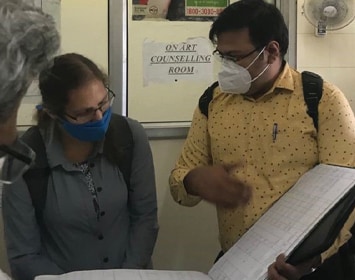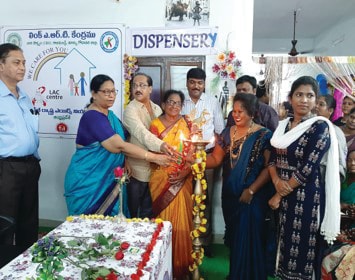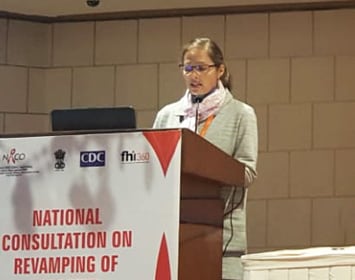HIV/AIDS
CDC is working with the Indian government to leverage partnerships and initiatives that help reach HIV epidemic control in India.
CDC has worked with the National AIDS Control Program (NACP) for over two decades. CDC and partners have worked with the GOI to implement evidence-based, high impact, and sustainable interventions in HIV/AIDS prevention, diagnostics, treatment, retention, and viral load suppression to reach people at risk of HIV and people living with HIV/AIDS (PLHIV), including key populations.
In 2001, CDC India launched the Global AIDS Program in the Government Hospital for Thoracic Medicine (GHTM) in Chennai, the capital of Tamil Nadu state. The launch of the U.S. President’s Emergency Plan for AIDS Relief (PEPFAR) expanded CDC India efforts, and CDC opened a satellite office in Chennai focused on innovative models for service delivery and education campaigns. In 2006, CDC and the Directorate of Medical Education, Tamil Nadu, launched the HIV Medicine and Leadership Fellowship, a one-year, hands-on training at the GHTM for HIV clinicians. Approximately 80 fellows completed the program and have contributed to many NACP successes nationwide. GHTM has become a nationally respected training and learning center.
CDC helped establish an information system at GHTM that turned paper records into an electronic medical system, allowing for better documentation, and improved patient care. After data showed that many patients were coming from the neighboring state, CDC expanded its footprint in Andhra Pradesh with support of the unified state government, which helped to pave the way for additional HIV/AIDS collaborations at the national level.

Dr. Melissa Nyendak, Program Director, CDC Division of Global HIV/TB, visits HIV clinic in Mumbai, Maharashtra, 2021

Launch of the first community based organization in the country to lead anti-retroviral service delivery for female sex workers, East Godavari, Andhra Pradesh, 2019 Photo credit: CDC India office

Dr. Melissa Nyendak, Program Director, CDC Division of Global HIV/TB, presenting at the National Consultation on Revamping of Targeted Intervention Under the National AIDS Control Program (NACP)
“Treat All”
This 2015 WHO policy recommends antiretroviral therapy (ART) for all PLHIV immediately after HIV diagnosis. CDC India’s technical support for patient care and center infrastructure have informed national guidelines. CDC helped design a systematic approach to track and trace clients with HIV with treatment interruption, who needed to be brought back to care. In 2017, the GOI launched the Mission Sampark strategy to bring PLHIV back to treatment.
Multi-month Dispensation (MMD) and Community-based Service Delivery
To help PLHIV stay in treatment, CDC supported GOI efforts to initiate and expand two innovative models to reach clients. The MMD model allows clients to receive three months of ART therapy during a medical care visit. The community-based delivery system model allows patients to receive HIV and TB medication closer to home, decreasing travel time as a barrier to care. During COVID-19, groundwork on these two innovative models were critical to avoid treatment interruption.
Client-centered Care
In 2016, CDC partnered with the National AIDS Control Organization (NACO) and State AIDS Control Societies (SACS) to launch “Project Sunrise” in the northeastern states of Mizoram, Manipur and Nagaland, where the incidence and prevalence of HIV are highest in India. Over the next five years, the project improved access to prevention and harm reduction for people who use intravenous drugs and expanded HIV testing and treatment in remote areas. The accomplishments were identified as a best practice for national adoption. In coordination with NACO, work continues under “Project Sunshine” to ensure clients at risk or living with HIV have access to community-based, client-centered prevention, testing, and treatment services.
Strengthening Laboratory Networks
In 2009, CDC started to provide technical assistance to 130 HIV national and state level laboratories towards international accreditation. The program scaled up to over 5,000 HIV testing sites, leading to a marked improvement in quality and timely diagnosis of HIV. CDC provided technical assistance to establish a tiered network of Blood Banks under NACO, leading to the development of national guidelines to harmonize transfusion practices across the country. Since the launch of routine HIV viral load testing in 2018, CDC provided technical assistance to improve routine viral load testing for an estimated 2.3 million PLHIV. This was possible through the optimization of 64 public sector molecular laboratories, strategic engagement of private laboratories, and support for capacity building efforts, quality assurance, and an accreditation program. To increase laboratory access for key populations in remote locations, CDC also worked with the national and local governments on innovative approaches for diagnostic network optimization and community-based laboratory service delivery.
Surveillance Population Size Estimates
CDC partnered with UNAIDS to support GOI in generating HIV estimates (e.g., adult HIV prevalence, number of PLHIV, annual new HIV infections and annual AIDS-related deaths) for tracking progress against the sustainable development goal indicators established by WHO. CDC supported sentinel surveillance and integrated biological and behavioral surveillance among key populations through WHO and other partners. CDC helped develop the strategy and guidelines for mapping and size estimation of key populations for the entire country to allow for more targeted programming of resources. CDC partnerships with NACO and Indian states on program impact and quality improvement contributed to the national strategic information management system known as Strengthening Overall Care for HIV beneficiaries.
CDC collaborates with NACO and other partners to support HIV prevention, care, and treatment efforts across the country. CDC supports the GOI’s use of real-time data for decision-making, including at the state and district levels to achieve program objectives. CDC is working with GOI to leverage partnerships and initiatives that help reach HIV epidemic control in India. CDC works with NACO to implement evidence-based, high impact, sustainable interventions in prevention, testing, linkage to treatment, retention, and viral load suppression to reach people at risk of HIV and PLHIV.